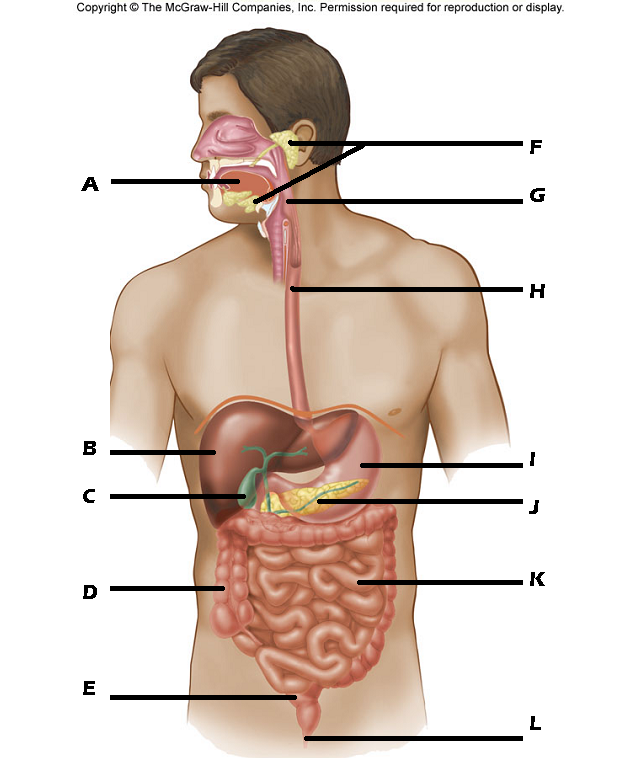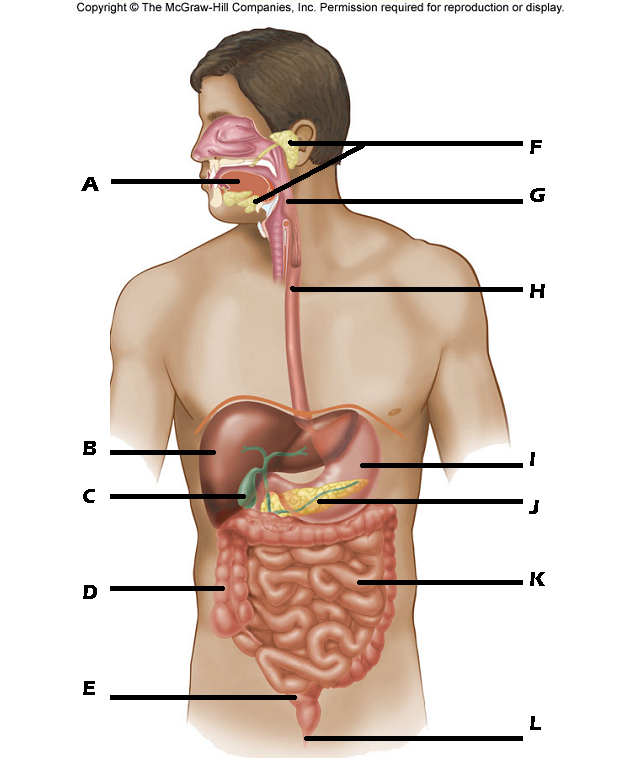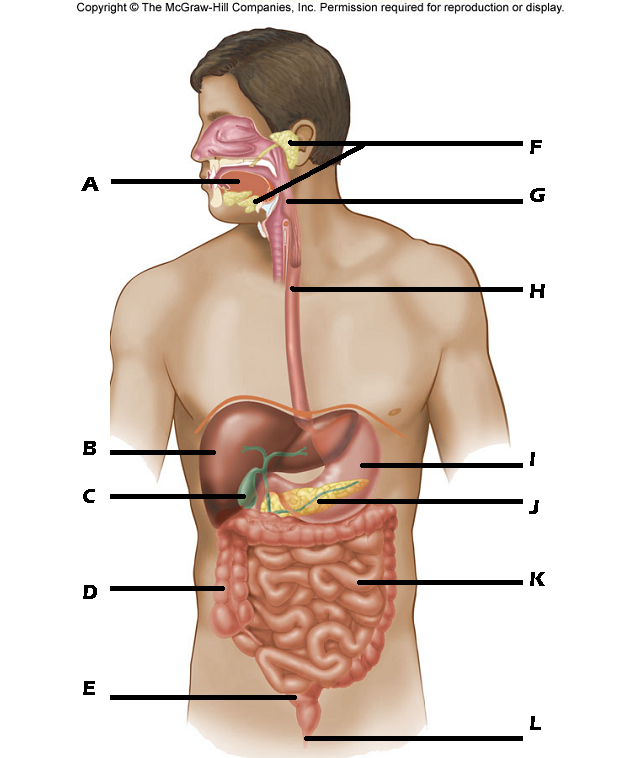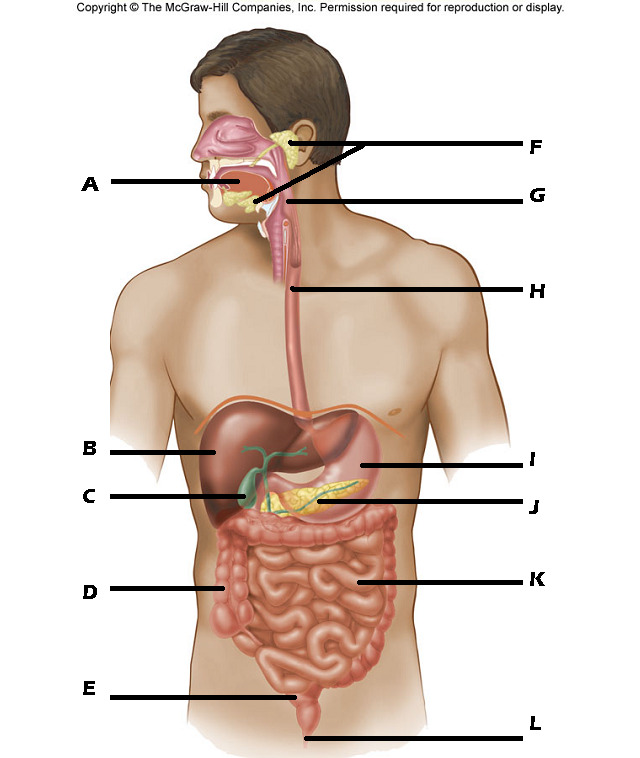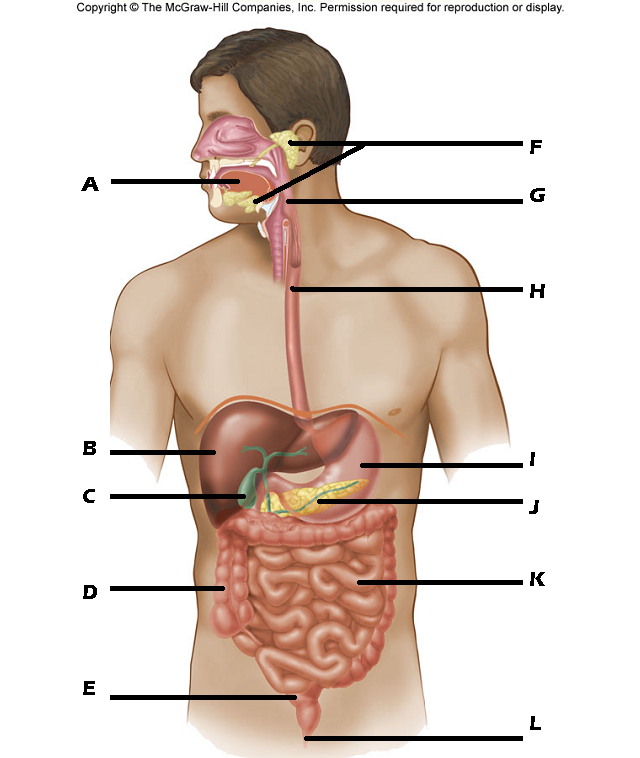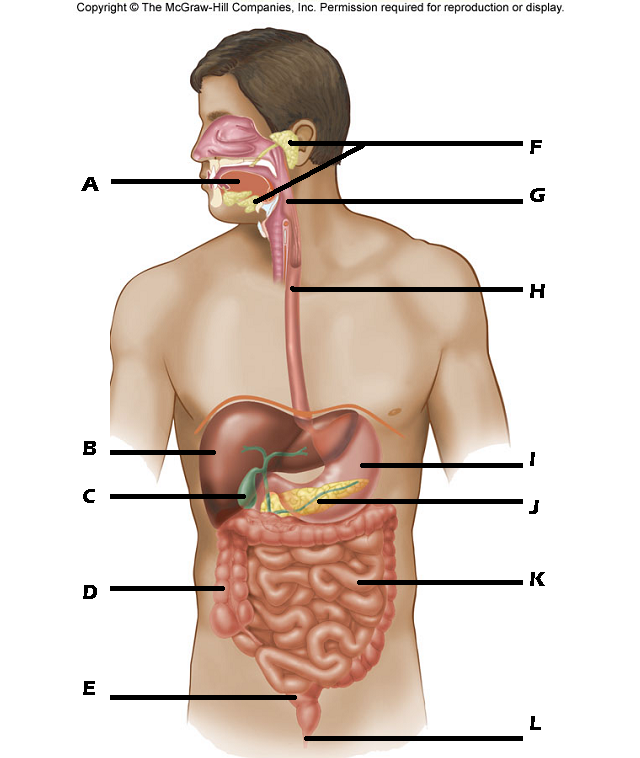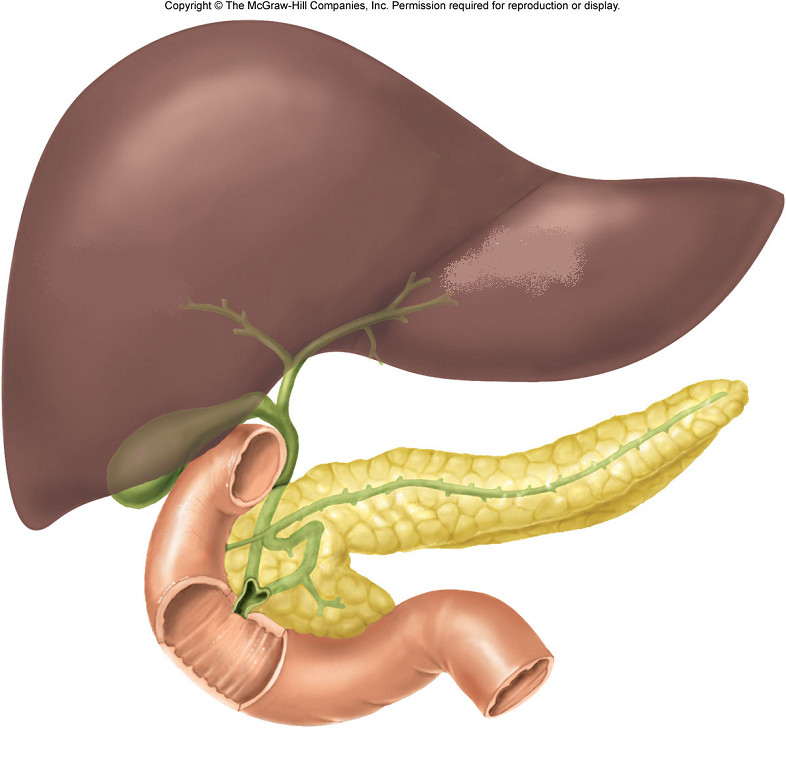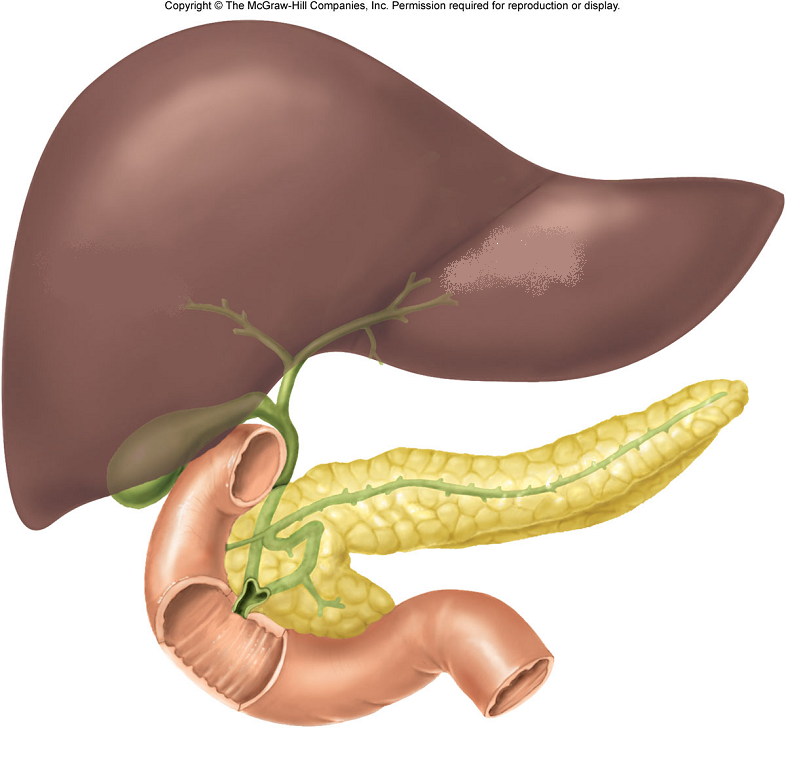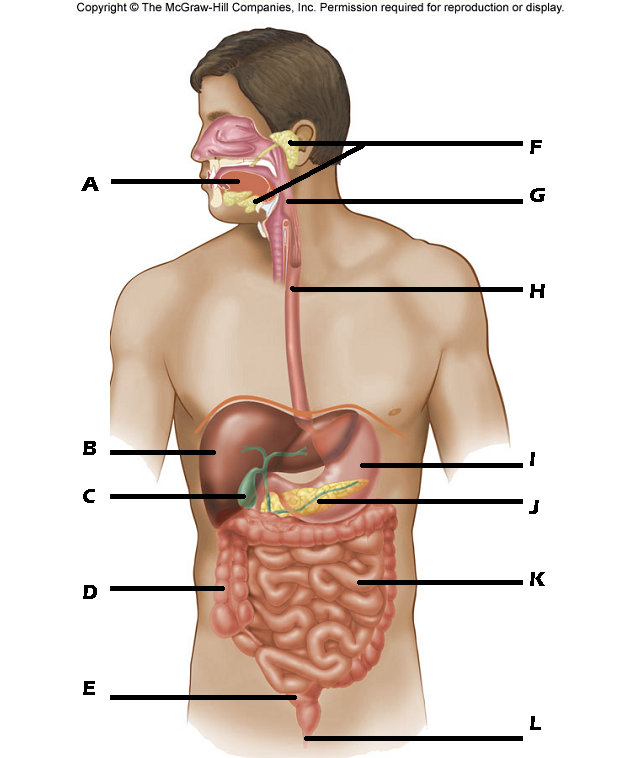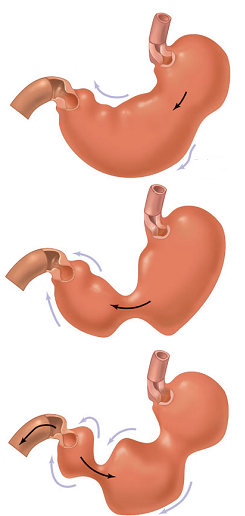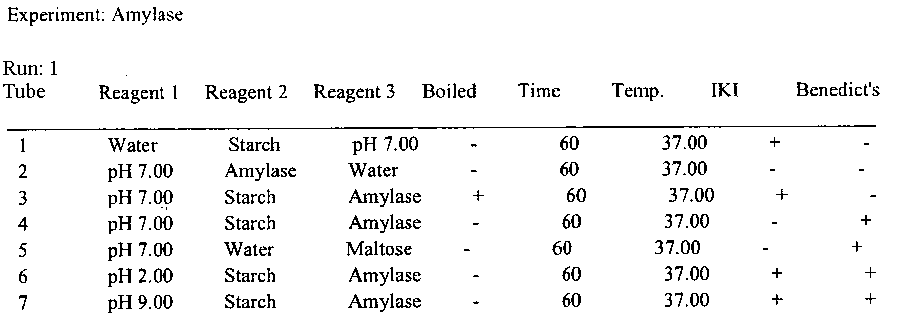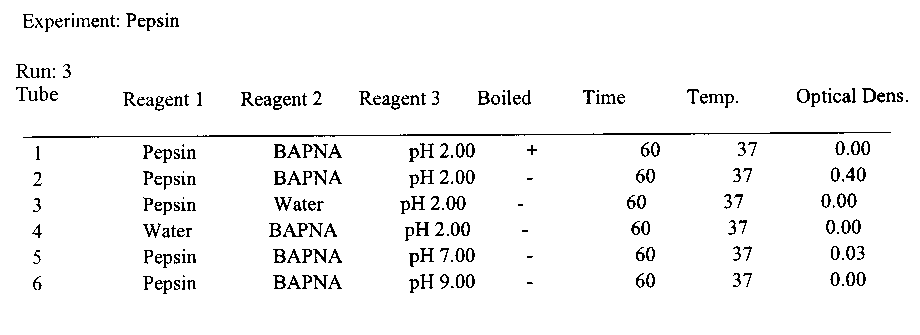Digestive System Practice Quiz 1
(270).jpg)
Digestive System preparation quiz
- 1.
Identify the Small Intestine:
- 2.
Identify the Liver:
Explanation
The correct answer is B because it is the only option provided in the question. Without any additional information or context, it is not possible to determine the specific reason why B is the correct answer.Rate this question:
- 3.
What is structure I?
Explanation
The correct answer is "stomach". The other options provided are misspellings of the word "stomach".Rate this question:
- 4.
Letter E is pointing to what structure?
Explanation
The letter E is pointing to the rectum. The rectum is the final portion of the large intestine that connects to the anus. It serves as a temporary storage site for feces before they are eliminated from the body.Rate this question:
- 5.
Which structure is the pharynx?
- 6.
What is structure L?
- 7.
What color is the pancreas in the diagram below?
- A.
Yellow
- B.
Peach
- C.
Green
- D.
Brown
Correct Answer
A. Yellow -
- 8.
In the diagram below, what color is the gall bladder?
- A.
Yellow
- B.
Peach
- C.
Green
- D.
Brown
Correct Answer
C. GreenExplanation
In the diagram, the gall bladder is depicted as green.Rate this question:
-
- 9.
Which letter is pointing to the large intestine (colon)?
Correct Answer
DExplanation
The letter "D" is pointing to the large intestine (colon) because it is the only letter that is connected to the rest of the digestive system in the diagram. The large intestine is responsible for absorbing water and electrolytes from the remaining indigestible food matter, forming feces, and eliminating waste from the body.Rate this question:
- 10.
Where is the esophagous?
Correct Answer
HExplanation
The esophagus is located in the human body. It is a muscular tube that connects the throat (pharynx) to the stomach. It is responsible for transporting food and liquids from the mouth to the stomach for digestion.Rate this question:
- 11.
This is where machanical digestion begins and chemical digestion of polysaccharides begin.
- A.
Mouth
- B.
Stomach
- C.
Liver
- D.
Small Intestine
- E.
None of the above
Correct Answer
A. MouthExplanation
The mouth is where mechanical digestion begins as the teeth break down food into smaller pieces through chewing. It is also where chemical digestion of polysaccharides begins, as the enzyme amylase is present in saliva and starts to break down complex carbohydrates into simpler sugars.Rate this question:
-
- 12.
This the 1st location in the digestive system where peristalsis occurs.
- A.
Mouth
- B.
Esophagous
- C.
Stomach
- D.
Small Intestine
- E.
Large Intestine
Correct Answer
B. EsophagousExplanation
The esophagus is the tube that connects the mouth to the stomach. It is responsible for transporting food from the mouth to the stomach through a series of coordinated muscle contractions called peristalsis. Peristalsis helps to push the food along the digestive tract by contracting and relaxing the muscles in a wave-like motion. Therefore, the esophagus is the first location in the digestive system where peristalsis occurs.Rate this question:
-
- 13.
This is where pepsinogens are activated into pesins to aid in the digestion of proteins.
- A.
Mouth
- B.
Esophagous
- C.
Stomach
- D.
Small Intestine
- E.
Pancreas
Correct Answer
C. StomachExplanation
The correct answer is the stomach. The stomach is where pepsinogens are activated into pepsins. Pepsins are enzymes that aid in the digestion of proteins.Rate this question:
-
- 14.
This organ releases many enzymes that aid in breakdown of all types of organic molecules.
- A.
Mouth
- B.
Gall Bladder
- C.
Stomach
- D.
Liver
- E.
Pancreas
Correct Answer
E. PancreasExplanation
The pancreas releases many enzymes that aid in the breakdown of all types of organic molecules. These enzymes include lipase, amylase, and protease, which help in the digestion of fats, carbohydrates, and proteins respectively. The pancreas plays a crucial role in the digestive system by producing and releasing these enzymes into the small intestine, where they help break down food and facilitate absorption. Therefore, the pancreas is the correct answer in this case.Rate this question:
-
- 15.
This tube typically is a passage for food and air (that you breathe).
- A.
Esophagous
- B.
Larynx
- C.
Trachea
- D.
Pharynx
- E.
Rectum.
Correct Answer
D. PharynxExplanation
The pharynx is the correct answer because it is a passage that serves as a common pathway for both food and air. It connects the nasal cavity and mouth to the esophagus and larynx, allowing food to pass into the esophagus for digestion and air to pass into the larynx for respiration. The trachea is solely responsible for air passage, while the esophagus is solely responsible for food passage. The rectum is not related to the passage of food and air.Rate this question:
-
- 16.
This organ produces bile.
- A.
Salivary Glands
- B.
Pancreas
- C.
Stomach
- D.
Liver
- E.
Gall Bladder
Correct Answer
D. LiverExplanation
The liver is responsible for producing bile, a substance that helps in the digestion and absorption of fats. Bile is stored in the gallbladder and released into the small intestine when needed. The liver also performs various other important functions in the body, such as detoxification, metabolism of nutrients, and production of certain proteins. Therefore, the liver is the correct answer for the organ that produces bile.Rate this question:
-
- 17.
This organ stores bile for use when fats enter the intestine.
- A.
Liver
- B.
Gall Bladder
- C.
Pancreas
- D.
Stomach
- E.
Salivary Glands
Correct Answer
B. Gall BladderExplanation
The gall bladder is the organ that stores bile for use when fats enter the intestine. Bile is produced by the liver and then stored in the gall bladder. When fats are consumed, the gall bladder contracts and releases bile into the small intestine to aid in the digestion and absorption of fats. The gall bladder plays a crucial role in the digestive process by storing and delivering bile as needed.Rate this question:
-
- 18.
This organ produces insulin which is required for glucose uptake into body cells.
- A.
Liver
- B.
Gall Bladder
- C.
Pancreas
- D.
Stomach
- E.
None of the above
Correct Answer
C. PancreasExplanation
The pancreas is the correct answer because it is the organ that produces insulin. Insulin is a hormone that is necessary for the uptake of glucose into body cells. The pancreas also plays a role in digestion by producing enzymes that help break down food in the small intestine. The liver, gall bladder, and stomach do not produce insulin and do not have a direct role in glucose uptake.Rate this question:
-
- 19.
The liver and the pancreas secrete their digestive juices into this part of the digestive system.
- A.
Stomach
- B.
Gall Bladder
- C.
Small Intestine
- D.
Large Intestine
- E.
Colon
Correct Answer
C. Small IntestineExplanation
The liver and pancreas secrete their digestive juices into the small intestine. This is because the small intestine is the primary site for digestion and absorption of nutrients. The liver produces bile, which helps in the breakdown and absorption of fats, and the pancreas produces digestive enzymes that break down proteins, carbohydrates, and fats. These digestive juices are released into the small intestine through ducts, where they mix with the partially digested food and further break it down for absorption into the bloodstream.Rate this question:
-
- 20.
Most organic molecules are absorbed at this place in the GI tract.
- A.
Mouth
- B.
Stomach
- C.
Gall Bladder
- D.
Small Intestine
- E.
They are absorbed equally throughout the digestive system.
Correct Answer
D. Small IntestineExplanation
The small intestine is the primary site of absorption in the gastrointestinal (GI) tract. It is responsible for the absorption of most organic molecules, including nutrients such as carbohydrates, proteins, and fats. The small intestine has a large surface area due to its long length and the presence of villi and microvilli, which increase the absorptive capacity. This allows for efficient absorption of nutrients into the bloodstream for distribution to the rest of the body.Rate this question:
-
- 21.
What are the small fingerlike projects on the walls of the small intestine? Hint: they are responsible for increasing the surface area as well as increasing the efficiency of absorbtion.
Correct Answer
villi
viliExplanation
The small fingerlike projections on the walls of the small intestine are called villi. These structures are responsible for increasing the surface area of the small intestine, which in turn increases the efficiency of absorption. The villi have a rich blood supply and contain specialized cells that aid in the absorption of nutrients from digested food.Rate this question:
- 22.
This organ's job is to absorb vitamins, minerals, and excess water.
Correct Answer
large intestineExplanation
The large intestine is responsible for absorbing vitamins, minerals, and excess water from the remaining undigested food material. It plays a crucial role in the final stages of digestion by reabsorbing water and electrolytes, and also by absorbing certain nutrients that were not absorbed in the small intestine. Additionally, the large intestine houses a large number of bacteria that aid in the fermentation of undigested carbohydrates and the production of certain vitamins.Rate this question:
- 23.
These 2 organs produce amylase:
- A.
Mouth
- B.
Esophagous
- C.
Stomach
- D.
Small Intestine
- E.
Pancreas
Correct Answer(s)
A. Mouth
E. PancreasExplanation
The mouth and pancreas produce amylase. Amylase is an enzyme that aids in the digestion of carbohydrates. In the mouth, salivary glands produce salivary amylase, which begins the breakdown of starches in food. The pancreas also produces pancreatic amylase, which is released into the small intestine to further break down carbohydrates.Rate this question:
-
- 24.
This picture is demonstrating the process of:
- A.
Elimination
- B.
Digestion
- C.
Absorption
- D.
Segmentation
- E.
Peristalsis
Correct Answer
E. PeristalsisExplanation
Peristalsis is the process depicted in the picture. Peristalsis refers to the rhythmic contractions and relaxations of the muscles in the digestive tract that help propel food through the system. These contractions occur in a wave-like motion, pushing the food forward and aiding in its movement along the digestive tract. This process is essential for the proper digestion and absorption of nutrients.Rate this question:
-
- 25.
Which of the following is not a major task of the digestive system?
- A.
Secretion
- B.
Digestion
- C.
Absorbtion
- D.
Elimination
- E.
Circulation
Correct Answer
E. CirculationExplanation
Circulation is not a major task of the digestive system. The digestive system is responsible for the breakdown of food into nutrients, which can then be absorbed by the body. Secretion refers to the production and release of digestive enzymes and fluids. Digestion is the process of breaking down food into smaller molecules. Absorption involves the uptake of nutrients into the bloodstream. Elimination refers to the removal of waste products from the body. Circulation, on the other hand, is primarily the responsibility of the cardiovascular system, which transports nutrients and oxygen throughout the body.Rate this question:
-
- 26.
Which of the following is not considered an accessory glad to the digestice system?
- A.
Wall of the GI tract
- B.
Salivary Glands
- C.
Liver
- D.
Pancreas
- E.
All of the above are accessory glands
Correct Answer
E. All of the above are accessory glandsExplanation
The correct answer is "All of the above are accessory glands." This means that all the options listed (Wall of the GI tract, Salivary Glands, Liver, and Pancreas) are considered accessory glands to the digestive system. The question is asking for the option that is NOT considered an accessory gland, and since all the options listed are considered accessory glands, the correct answer is that there is no option that is not considered an accessory gland.Rate this question:
-
- 27.
True or False: Sphincters are located throughout the digestive system and they control the direction and rate of flow of food.
- A.
True
- B.
False
Correct Answer
A. TrueExplanation
Sphincters are indeed located throughout the digestive system and play a crucial role in controlling the direction and rate of flow of food. These muscular rings act as valves, opening and closing to regulate the movement of food and prevent backflow. By contracting and relaxing, sphincters ensure that food progresses through the digestive tract in a coordinated and controlled manner, allowing for proper digestion and absorption of nutrients.Rate this question:
-
- 28.
What are the normal pHs of the mouth, stomach, and small intestine, respectively. (In order as listed.)
- A.
3, 3. 3
- B.
7, 3, 7
- C.
3, 3, 7
- D.
3, 7, 7
Correct Answer
B. 7, 3, 7Explanation
The normal pH of the mouth is 7, which is considered neutral. The normal pH of the stomach is 3, which is highly acidic due to the presence of hydrochloric acid. The normal pH of the small intestine is 7, which is slightly alkaline. Therefore, the correct answer is 7, 3, 7.Rate this question:
-
- 29.
Which macromolecule does amylase break down?
- A.
Carbohydrates
- B.
Proteins
- C.
Lipids
- D.
Nucleic Acids
- E.
All of the above
Correct Answer
A. CarbohydratesExplanation
Amylase is an enzyme that specifically breaks down carbohydrates. It catalyzes the hydrolysis of starch and glycogen into smaller glucose units. This process is crucial for the digestion and absorption of carbohydrates in the body. Therefore, the correct answer is carbohydrates.Rate this question:
-
- 30.
Which organ performs all these functions, and then some: Glycogen storage Detoxification of toxins alcohol Controls many metabolic activities Converts ammonia to urea Degradation of worn out red blood cells
- A.
Mouth
- B.
Stomach
- C.
Liver
- D.
Pancreas
- E.
Spleen
Correct Answer
C. LiverExplanation
The liver performs all of the mentioned functions and more. It is responsible for storing glycogen, detoxifying toxins such as alcohol, controlling various metabolic activities, converting ammonia to urea, and degrading worn out red blood cells. The liver is a vital organ that plays a crucial role in maintaining overall health and well-being.Rate this question:
-
- 31.
What are villi? Describe their structure, location and function.
- 32.
Fatty acids are absorbed _____________________________.
- A.
Into the bloodstream at the small intestine.
- B.
Into the lymph vessels from the bloodstream.
- C.
Into the lymph vessels at the small intestine.
- D.
Into the bloodsteam at the stomach
Correct Answer
C. Into the lymph vessels at the small intestine.Explanation
Fatty acids are absorbed into the lymph vessels at the small intestine. This is because the small intestine has specialized structures called lacteals, which are part of the lymphatic system. These lacteals absorb the fatty acids and other fat-soluble nutrients from the digested food, and then transport them into the lymph vessels. From there, they eventually enter the bloodstream and are distributed to different parts of the body.Rate this question:
-
- 33.
Which of the following does not need to be chemically digested further to be absorbed?
- A.
Polysaccharides
- B.
Lipids
- C.
Nucleic Acids
- D.
Amino Acids
- E.
None of these molecules are ready to be absorbed
Correct Answer
D. Amino AcidsExplanation
Amino acids do not need to be chemically digested further to be absorbed because they are the building blocks of proteins and are already in a form that can be easily absorbed by the body. Once amino acids are broken down from proteins during the process of digestion, they can be readily absorbed into the bloodstream and used for various biological processes in the body.Rate this question:
-
- 34.
Which of the following is an example of a monosaccharide?
- A.
Glycerol
- B.
Glucose
- C.
Glycogen
- D.
Glow Sticks
Correct Answer
B. GlucoseExplanation
Glucose is an example of a monosaccharide because it is a simple sugar that cannot be further broken down into smaller sugar molecules. Monosaccharides are the building blocks of carbohydrates and are composed of a single sugar unit. Glycerol, glycogen, and glow sticks are not monosaccharides. Glycerol is a type of alcohol, glycogen is a complex carbohydrate made up of many glucose units, and glow sticks are chemical products used for illumination.Rate this question:
-
- 35.
What did the rectum do?
- A.
Darn near killed 'em.
- B.
X
Correct Answer
A. Darn near killed 'em. -
- 36.
True or False: Minerals are organic substances such as ascorbic acid.
- A.
True
- B.
False
Correct Answer
B. FalseExplanation
Minerals are inorganic substances that are naturally occurring and have a crystalline structure. Ascorbic acid, on the other hand, is a form of vitamin C and is considered an organic substance. Therefore, the statement that minerals are organic substances such as ascorbic acid is false.Rate this question:
-
- 37.
Which of the following is a false statement about vitamins?
- A.
Vitamins are important to our health and are available by eating a variety of foods.
- B.
Vitamin D can be produced by the skin due to sun exposure.
- C.
Without vitamin C, a person can get scurvy.
- D.
Vitamins are larger organic molecules.
- E.
Vitamins are enzymes and are therefore made of amino acids
Correct Answer
E. Vitamins are enzymes and are therefore made of amino acidsExplanation
Vitamins are not enzymes and they are not made of amino acids. Vitamins are organic compounds that are essential for normal physiological functions in the body. They are required in small amounts and cannot be synthesized by the body in sufficient quantities, hence they need to be obtained through diet. Enzymes, on the other hand, are proteins that act as catalysts in biochemical reactions and are made up of amino acids.Rate this question:
-
- 38.
When lipids are broken down by lipase, what monomers are produced?
- A.
Nucleotides
- B.
Monosacharrides
- C.
Amino Acids
- D.
Glycerol and Fatty Acids
- E.
None of the above
Correct Answer
D. Glycerol and Fatty AcidsExplanation
When lipids are broken down by lipase, the monomers produced are glycerol and fatty acids. Lipase is an enzyme that catalyzes the hydrolysis of lipids, breaking them down into their component parts. Glycerol and fatty acids are the building blocks of lipids, and when lipase acts on lipids, it breaks the ester bonds between the glycerol molecule and the fatty acid chains, resulting in the release of glycerol and fatty acids as monomers. Therefore, the correct answer is glycerol and fatty acids.Rate this question:
-
- 39.
What enzyme is responsible for thechemical breakdown of nucleic acids?
Correct Answer
nuclease
pancreatic nuclease
intestinal nuclease
nucleasExplanation
The correct answer is nuclease, pancreatic nuclease, intestinal nuclease, nucleas. Nucleases are enzymes responsible for the chemical breakdown of nucleic acids. Pancreatic nuclease and intestinal nuclease are specific types of nucleases found in the pancreas and intestines, respectively. Nucleas is likely a misspelling of nuclease. These enzymes play a crucial role in the digestion and metabolism of nucleic acids in the body.Rate this question:
- 40.
Which of the following could not be the result of many simple sugar molecules linked together?
- A.
Cellulose
- B.
Glycogen
- C.
Starch
- D.
Dissacharides
- E.
All of the above are molecules made of simple sugars
Correct Answer
E. All of the above are molecules made of simple sugarsExplanation
All of the options listed (cellulose, glycogen, starch, and disaccharides) are indeed molecules made of simple sugars. Cellulose is a polysaccharide made of glucose molecules, glycogen is a polysaccharide made of glucose molecules, starch is a polysaccharide made of glucose molecules, and disaccharides are formed by linking two simple sugar molecules together. Therefore, all of the above options could be the result of many simple sugar molecules linked together.Rate this question:
-
- 41.
Which of the following is a true statement about bile?
- A.
Bile is an enzyme.
- B.
Bile cannot be stored for late use.
- C.
Bile causes an increase in the production of lipase.
- D.
Bile is my mibble name
- E.
Bile emmulsifies fat so it has a larger surface area for digestion.
Correct Answer
E. Bile emmulsifies fat so it has a larger surface area for digestion.Explanation
Bile is a substance produced by the liver and stored in the gallbladder. It is not an enzyme itself, but it contains bile salts which help in the digestion and absorption of fats. Bile emulsifies fat, breaking it down into smaller droplets, which increases the surface area available for the action of lipase, an enzyme that breaks down fats. This process aids in the digestion and absorption of fats in the small intestine. Therefore, the statement "Bile emulsifies fat so it has a larger surface area for digestion" is true.Rate this question:
-
- 42.
Which hormone is secreted into the bloodsteam when proteins are present in the stomach? As a result, this hormone stimulates the sectretion of acid into the stomach.
- A.
Gastrin
- B.
CCK (cholecystokinin)
- C.
GIP (glucose insulinotropic peptide)
- D.
Pepsin
- E.
Secretin
Correct Answer
A. GastrinExplanation
Gastrin is the correct answer because it is a hormone that is secreted into the bloodstream when proteins are present in the stomach. It stimulates the secretion of acid into the stomach, which aids in the digestion of proteins.Rate this question:
-
- 43.
This hormore is secreted in order to induce bicarbonate production which will reduce the acidity of the food coming from the stomach into the small intestine.
- A.
Gastrin
- B.
CCK (cholecystokinin)
- C.
GIP (glucose insulinotropic peptide)
- D.
Pepsin
- E.
Secretin
Correct Answer
E. SecretinExplanation
Secretin is the correct answer because it is a hormone that is secreted in response to the acidity of the food in the small intestine. It stimulates the pancreas to release bicarbonate ions, which helps to neutralize the acid and reduce the acidity of the food. This is important because the enzymes in the small intestine work best in a slightly alkaline environment. Therefore, the secretion of secretin helps to maintain the optimal pH for digestion and absorption in the small intestine.Rate this question:
-
- 44.
This hormone increases production of pancreatic secretions and gall bladder contraction in response to the presence of fatty acids in the small intestine.
- A.
Gastrin
- B.
CCK (cholecystokinin)
- C.
GIP (glucose insulinotropic peptide)
- D.
Pepsin
- E.
Secretin
Correct Answer
B. CCK (cholecystokinin)Explanation
CCK (cholecystokinin) is the correct answer because it is a hormone that is released in response to the presence of fatty acids in the small intestine. It stimulates the production of pancreatic secretions, including digestive enzymes, and also causes the contraction of the gall bladder, which releases bile into the small intestine to aid in the digestion and absorption of fats. Gastrin is a hormone that stimulates the release of gastric acid in the stomach. GIP (glucose insulinotropic peptide) is a hormone that stimulates insulin release in response to the presence of glucose. Pepsin is an enzyme involved in the digestion of proteins. Secretin is a hormone that stimulates the release of bicarbonate from the pancreas to neutralize stomach acid in the small intestine.Rate this question:
-
- 45.
This hormone triggers the release of insulin from the pancreas.
- A.
Gastrin
- B.
CCK (cholecystokinin)
- C.
GIP (glucose insulinotropic peptide)
- D.
Pepsin
- E.
Secretin
Correct Answer
C. GIP (glucose insulinotropic peptide)Explanation
GIP (glucose insulinotropic peptide) is the correct answer because it is a hormone that stimulates the release of insulin from the pancreas. Insulin helps to regulate blood sugar levels by promoting the uptake of glucose from the bloodstream into cells. GIP is released from the small intestine in response to the presence of glucose in the digestive system, and it plays a role in the regulation of insulin secretion after meals.Rate this question:
-
- 46.
At what point within the digestive system does the chemical digetion of lipids begin?
- A.
Mouth
- B.
Stomach
- C.
Small Intestine
- D.
Large Intestine
- E.
Colon
Correct Answer
C. Small IntestineExplanation
The chemical digestion of lipids begins in the small intestine. This is where the majority of lipid digestion takes place. The small intestine produces and releases enzymes called lipases, which break down lipids into smaller molecules called fatty acids and glycerol. These smaller molecules can then be absorbed into the bloodstream and used for energy or stored as fat. The mouth and stomach do not play a significant role in lipid digestion, while the large intestine and colon primarily absorb water and electrolytes, not lipids.Rate this question:
-
- 47.
Peristalsis, in the GI tract, is aided by the use of theis type of muscle:
- A.
Smooth muscle
- B.
Cardiac muscle
- C.
Skeletal muscle
- D.
None of the above
Correct Answer
A. Smooth muscleExplanation
Peristalsis is the process of wave-like muscle contractions that propel food through the gastrointestinal tract. Smooth muscle is responsible for this movement as it is found in the walls of the digestive organs, such as the stomach and intestines. Unlike skeletal muscle, which is under voluntary control, smooth muscle contracts involuntarily and rhythmically, allowing for the coordinated movement of food along the digestive tract. Cardiac muscle, on the other hand, is found in the heart and is responsible for its contraction. Therefore, the correct answer is smooth muscle.Rate this question:
-
- 48.
Under what pH has optimal breakdown of starch occured?
- A.
PH = 2
- B.
PH = 7
- C.
PH = 9
- D.
Works eually well at all three.
- E.
Not enough information.
Correct Answer
B. PH = 7Explanation
Optimal breakdown of starch occurs at a pH of 7. This is because enzymes called amylases, which are responsible for breaking down starch, work best at a neutral pH. At pH 2, the acidic environment may denature or inactivate the amylase enzymes, reducing their effectiveness. Similarly, at pH 9, the alkaline environment may also affect the activity of the enzymes. Therefore, pH 7 is the ideal condition for the optimal breakdown of starch.Rate this question:
-
- 49.
Compare tubes 3 and 4. What can we conclude from these 2 trials?
- A.
PH affects amylase's ability to break down cellulose.
- B.
Bacteria can break down cellulose.
- C.
Amylase can break down cellulose if it is boiled 1st.
- D.
Amylase doe not break down cellulose.
- E.
None of the Above.
Correct Answer
D. Amylase doe not break down cellulose.Explanation
From comparing tubes 3 and 4, we can conclude that amylase does not break down cellulose.Rate this question:
-
- 50.
Which tube demonstrates the optimal conditions for the breakdown of the protein BAPNA?
- A.
Tube 1
- B.
Tube 2
- C.
Tube 4
- D.
Tube 5
- E.
Tube 6
Correct Answer
B. Tube 2Explanation
Tube 2 demonstrates the optimal conditions for the breakdown of the protein BAPNA.Rate this question:
-
Quiz Review Timeline +
Our quizzes are rigorously reviewed, monitored and continuously updated by our expert board to maintain accuracy, relevance, and timeliness.
-
Current Version
-
Mar 21, 2023Quiz Edited by
ProProfs Editorial Team -
Apr 27, 2010Quiz Created by
Suzicrase
 Back to top
Back to top



